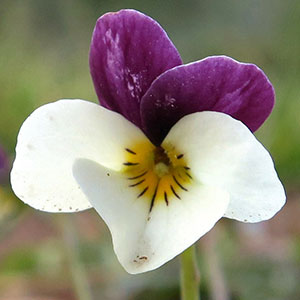Viola sheltonii
Viola hallii
cut-leaf violet, fan violet, Shelton's violet
Hall's violet, Oregon violet, wild pansy
1–3, prostrate, decumbent, or erect, glabrous or sparsely puberulent, from short, often vertical, deep-seated or usually shallow, subligneous rhizome.
1–3, decumbent or ascending to erect, ca. 1/2 subterranean, glabrous, clustered on single, short, vertical, deep-seated caudex.
basal and cauline;
basal: 1–3, palmately compound, leaflets 3;
stipules lanceolate-ovate, margins laciniate with gland-tipped projections, apex acute to acuminate;
petiole 8.6–21 cm, glabrous or sparsely puberulent;
blade reniform or ovate to ± orbiculate, 2–7 × 2–11 cm, coriaceous, base tapered, each leaflet cleft or dissected into 3 ± obovate lobes, each lobe further divided into 2–3 oblanceolate, pandurate, spatulate, oblong, lanceolate, or elliptic, lobes 2–10 mm wide, margins entire, ciliate or eciliate, apex acute to obtuse, mucronulate, surfaces glabrous or sparsely puberulent;
cauline similar to basal except: stipules ovate to lanceolate, margin projections gland-tipped or eglandular, apex long-acuminate;
petiole 5.5–12 cm;
blade 1.2–6.3 × 1.2–10.5 cm.
basal and cauline;
basal: 1–4, palmately compound, ± 2-ternate or 3-ternate, leaflets 3;
stipules adnate to petiole, forming 2 linear-lanceolate wings, unlobed, margins entire, apex of each wing free, acute;
petiole 5–8 cm, glabrous;
blade ovate to deltate, 2.8–6 × 2.6–6.5 cm, ± coriaceous, base tapered, ultimate lobes narrowly elliptic, lanceolate, or oblanceolate, 1–7 mm wide, margins entire, ciliate or eciliate, apex acute, mucronulate, surfaces glabrous;
cauline similar to basal except: stipules usually lanceolate, sometimes broadly ovate, ± leaflike, margins toothed;
petiole 1.3–6 cm;
blade 2–4.8 × 1.2–5.5 cm.
5–19 cm, glabrous or sparsely puberulent.
2.5–11 cm, glabrous.
sepals lanceolate, margins ciliate or eciliate, auricles 0.5–1 mm;
petals deep lemon-yellow adaxially, upper 2 dark brown to brownish purple abaxially, lower 3 and sometimes upper 2 brownish purple-veined, lateral 2 bearded or beardless, lowest 7–18 mm, spur yellowish with brownish purple specks, gibbous, 1–2 mm;
style head bearded; cleistogamous flowers axillary.
sepals lanceolate to ovate, margins ciliate, auricles 0.5–1 mm;
petals: upper 2 almost black abaxially, dark reddish violet adaxially, lower 3 pale yellow, cream, or ± white, lateral 2 bearded, with deep yellow to orange patch basally, dark reddish violet-veined, lowest with deep yellow to orange patch basally, dark reddish violet-veined, 5–18 mm, spur yellow, gibbous, 0.5–2 mm;
style head bearded; cleistogamous flowers absent.
oblong to ovoid, 6–8 mm, glabrous or puberulent.
ellipsoid, 4–12 mm, glabrous.
brownish, shiny, ca. 2.5 mm.
light brown, shiny, 3.2–3.5 mm.
= 12.
= 60, 72.
Viola sheltonii
Viola hallii
The cleistogamous flowers of Viola sheltonii are borne on long, prostrate peduncles usually buried in duff around the plant. Mature cleistogamous capsules are usually hidden and the dehisced seeds remain close to the parent plant. Some populations of V. sheltonii produce only cleistogamous flowers (D. Klaber 1976).
(Discussion copyrighted by Flora of North America; reprinted with permission.)
Viola hallii was discovered on the grounds of Willamette University in Salem, Oregon, by Elihu Hall, a professor at that institution (V. B. Baird 1942). Leaves of V. hallii are similar to V. beckwithii.
(Discussion copyrighted by Flora of North America; reprinted with permission.)


